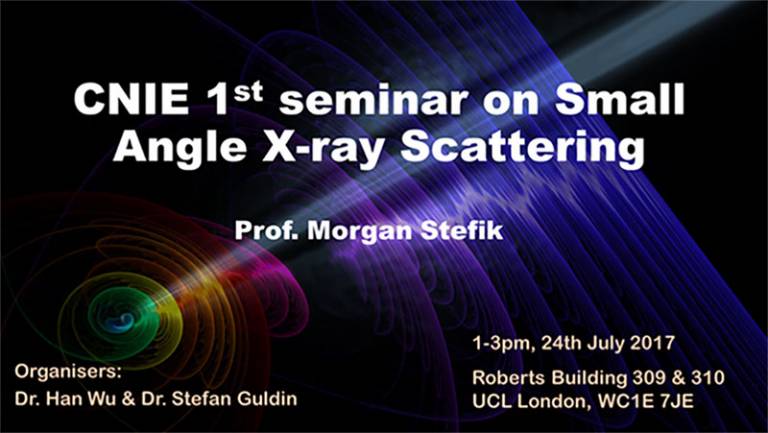CNIE-SAXS Seminar and Networking Event: Adventures with Small-Angle X-Ray Scattering at USC - 24 July, 1-3pm.
18 July 2017


It is our great pleasure to announce our first SAXS Seminar organised by Dr Han Wu and Dr Stefan Guldin Adventures with Small-Angle X-Ray Scattering at USC, in room 309 from 1-2pm. The event will be followed by a networking session from 2-3pm in Roberts Building 310, anyone is welcome to chat and have tea and cakes.
You only need to register for the networking event on Eventbrite for catering purposes.
The talk will be given by Prof. Morgan Stefik from the University of South Carolina. He is a leading Scientist working on Functional nanostructures, block copolymers, self-assembly and nanoparticles with many years of experience of SAXS and GISAXS and high impact publications
Abstract
The University of South Carolina recently started a SAXS facility that was quickly integrated into ongoing nanomaterials research activities. Here SAXS uniquely enables nanoscale measurements (1-150 nm) across macroscopic samples (~0.1 mm3) with minimal sample preparation. Data analysis yields information about shape, orientation, and dimension as well as the distributions thereof. The latest generation of lab scale instrument enables fast routine measurements within a few minutes and sometimes few-second time resolution for in situ processes. Using the same model of SAXS instrument as UCL, we will highlight our recent examples of SAXS in nanomaterials research at USC. Examples will include the self-assembly of tunable nanomaterials, ordered block copolymers, polymer thermodynamics, nanoparticle size distributions, inorganic thin films, and in situ crystallization.
Key publications
Lokupitiya, H. N.; Jones, A.; Reid, B.; Guldin, S.; Stefik M.* Ordered Mesoporous to Macroporous Oxides with Tunable Isomorphic Architectures – Solution Criteria for Persistent Micelle Templates. Chemistry of Materials 2016, 28(6), 1653-1667.
Lokupitiya, H. N.; Stefik, M.* Cavitation-Enabled Rapid and Tunable Evolution of High-χN Micelles as Templates for Ordered Mesoporous Oxides. Nanoscale 2017, 9, 1393-1397.
Stefik, M.* Atomic Layer Deposition of Bismuth Vanadates for Solar Energy Materials.ChemSusChem 2016, 9, 1727-1735.
Lamm, B.; Sarkar, A. Stefik, M.* Surface Functionalized Atomic Layer Deposition of Bismuth Vanadate for Single-Phase Scheelite. Journal of Materials Chemistry A 2017, ASAP. 10.1039/C6TA09485F
Peters, K.; Lokupitiya, H. N.; Sarauli, D.; Labs, M.; Pribil, M.; Rathousky, J.; Kuhn, A.; Leister*, D.; Stefik, M.*; Fattakhova-Rohfling, D.* Nanostructured Antimony-Doped Tin Oxide Layers with Tunable Pore Architectures as Versatile Transparent Current Collectors for Biophotovoltaics. Advanced Functional Materials 2016, 26, 6682–6692.
Biography
Morgan Stefik obtained a degree in Materials Engineering from Cal Poly SLO in 2005 before completing doctoral studies in Materials Science at Cornell University under Prof. U. Wiesner and Prof. F. J. DiSalvo in 2010. After two years of postdoctoral research at École Polytechnique Fédérale de Lausanne with Prof. M. Grätzel, he joined the University of South Carolina in 2013 as an Assistant Professor in the Department of Chemistry and Biochemistry.
He is the founding director of the South Carolina SAXS Collaborative, a NSF supported facility. His research focus is nanomaterials chemistry with emphasis on self-assembly techniques and atomic layer deposition.
Research Interests
Functional nanostructures, energy devices, block copolymers, self-assembly, nanoparticles, photonics, atomic layer deposition, (photo)electrochemistry.
The Stefik group is developing new polymer derived nanomaterials and alternative energy devices. We are interested in bottom-up methods based upon the self-assembly of either polymers, nanoparticles, or mixtures thereof to form materials with nanoscale control. Such high-surface area materials are critical for developing numerous energy applications such as fuel cells, batteries, supercapacitors, photovoltaics, and solar fuels. Our focus on bottom-up methods make our discoveries easily deployable to industry for a significant and real impact.
 Close
Close



